A new season of (customers) success.
Here at Imagicle, this spring something exceptional has blossomed: a brand new team entirely dedicated to the success of our customers. My name is Tommaso, I joined the Imagicle sales team taking care of the North Italy, UK, & Ireland theaters, and today I am engaged in this new adventure (I have excellent travel companions, though!). In this post, I will tell you what the purpose of the Customer Success Team is, who it is composed of, and the advantages it brings to you, whether you are a partner or an end-user.
Benefits for partners.
Below I have tried to summarize the advantages of having a success-oriented team as a vendor if you are one of our partners (but surely, over time, I will have to extend this list):
- First, you will have a single team for renewal ready to help you with the same process worldwide.
- You’ll be able to count on a team that is closer to the end-user and helps it to discover all the advantages, integrations, and possible combinations of Imagicle solutions to make his job easier.
- Even if the purchasing process always takes place through the partner (i.e., you) thanks to our go-to-market 100% indirect, the Customer Success Team will always be there to help you and your customer renew the Imagicle solution.
Benefits for end-user.
If you are an end-user, you will have no fewer advantages. Indeed, they all concern you!
- You will have a dedicated team ready to help you through the whole journey with the Imagicle solutions and allow you to take full advantage of all their potential to make your job faster, smarter and easier.
- You will have a team of people always available to listen to your needs and collect your feedback and ideas.
- You can be sure: this team was created specifically to help you achieve your goals and succeed with your business, so you can count on it.
What Customer Success really is.
Of course, it’s a phrase that those who work in companies (no matter the industry) hear constantly. But what exactly do we mean by customer success?
Let me start with an “academic definition” to introduce the concept. Of course, there’s a lot of them out there, but I‘d go with the Gartner one: “Customer success is a method for ensuring customers reach their desired outcomes when using an organization’s product or service. A relationship-focused customer success strategy includes involvement in the purchase decision, implementation and use of products or services and customer support”.
In a nutshell, customer success aims to help customers reach their business goals through the product/services bought, giving the best experience to the customers in terms of onboarding, user experience, assistance, and relationship.
In this scenario, the are 3 different benefits that a company can get thanks to a good customer success structure. They are clearly described in a book titled: Customer Success – How Innovative Companies Are Reducing Churn and Growing Revenue by Nick Mehta, Dan Steinman, and Lincoln Murphy:
- Reduce/Manage Churn
- Drive Increased Contract Value From Existing Customers
- Improve the customer experience and the customer satisfaction
Let’s take a look at each of them.
1. Reduce/Manage Churn
Churn is the number 1 enemy for three subjects: companies, customer success teams, and recurring revenue business.
Hubspot defines customer churn as “the percentage of customers that stopped using your company’s product or service during a certain time frame.”
Such definition is enough to explain why it’s crucial to have some dedicated KPIs to monitor the churn situation and take strategic decisions.
Okay, you may say, but how can we calculate the customer churn rate?
The customer churn rate is calculated by dividing the number of customers you lost during a given period (for example, a month, a quarter, or a year) by the number of customers you had at the beginning of that given period.
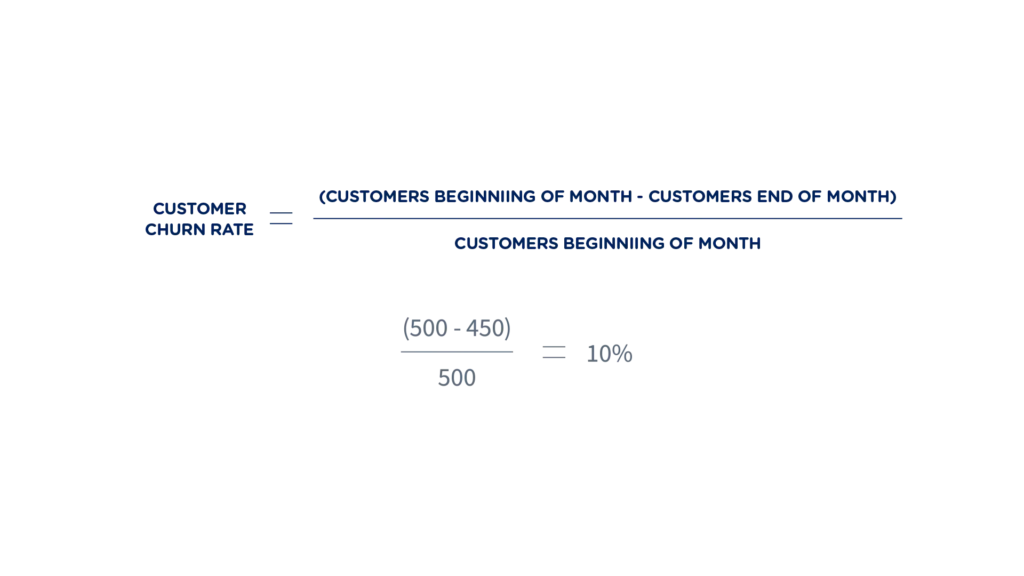
Once you’ve understood what customer churn is and how to calculate it, to understand the customer loss’s economic impact you would need to understand the difference between customer churn rate and revenue churn rate. This example from Salesforce makes it very clear:
“Customer churn and revenue churn are not always the same. As an example, let’s say that Company ADG has 2 product lines:
#1: Basic: 5,000 customers that pay $500/month per customer = $2,500,000 MRR
#2: Premium:1,000 customers that pay $1,250/month per customer = $1,250,000 MRR
This gives Company ADG a total of 6,000 customers and $3,750,000 MRR. Let’s also say that in one month, 180 basic customers and 20 premium customers churn. See the example below to review the customer churn and revenue churn rates.”
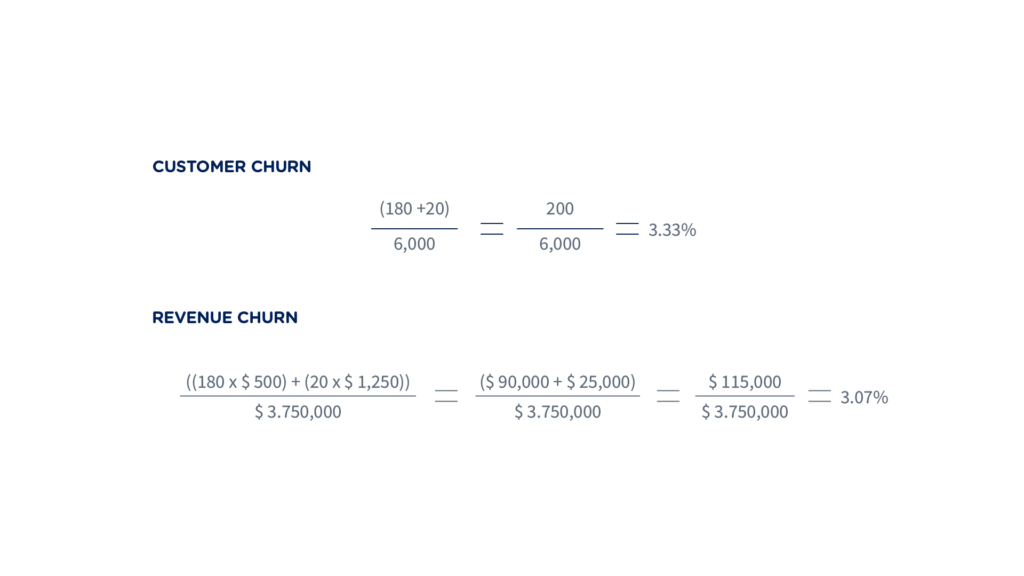
2. Drive Increased Contract Value From Existing Customers
Data, as you know, allow us to understand a lot of very important thing of about our customers, such as:
- their buying behavior;
- how they’re using our solutions;
- their issues.
This kind of information allows us to understand how to help them solve their problems by suggesting new solutions (cross-selling), changing the way they’re actually using them, or maybe adding features (upselling). Plus, thanks to the use of AI, we may try to anticipate their buying behavior and trends.
Now, it becomes clear how having a data-driven customer success team is essential to understanding how to increase contract value from existing customers and make sure the customer is happy with our solutions.
Let me share this example from the interview with Mark Nelson, Tableau President and CEO at Forbes, about an issue with the NFL team Seattle Seahawks.
“The Seattle Seahawks recently used data to make an important business decision. If you’ve ever attended a large stadium event, you know that hearing the sounds and calls from the field can make or break your experience. Fan feedback is a critical source of data for the Seahawks, and fans were displeased with the stadium’s audio quality. Rather than replace audio across the entire stadium, the Seahawks decided to explore the data further. A deep dive into the data revealed that audio quality was poor only in the four corners of the stadium. Instead of a pricey replacement of the full audio system, improvements were made in the targeted areas. This resulted in significant cost savings for the organization and a near immediate, positive turnaround in fan feedback— a huge data exploration win.”
Think of how happy a customer can be in a case like this if the success team is able to find the right solution for the company just by analyzing its users’ needs and analyzing its data. And as you know, customers’ happiness is something that lasts a long time, a real success.
3. Improve the customer experience and satisfaction
Last but not least, there’s the importance of delivering the best customer experience from the use of the solutions to the whole relationship with the company.
Customer relationships begin only after they subscribe to your product and start using your platform. Onboarding is no longer enough to make the relationship work. Instead, consistent touchpoints (whether automated or manual) are necessary to provide an exemplary customer experience.
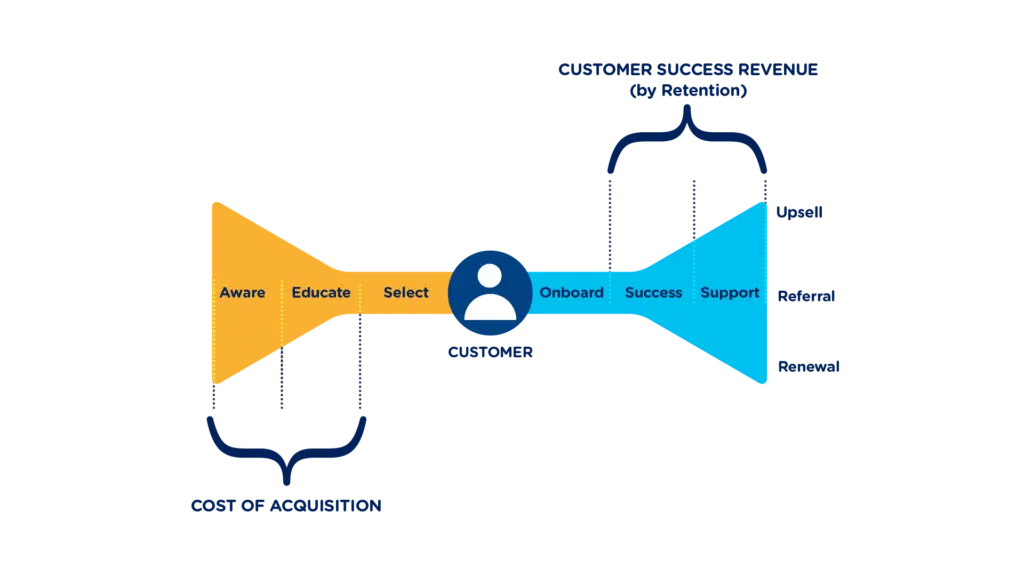
The importance of word of mouth.
We have seen that the Customer Success Team has to consider a process with different touchpoints and milestones to get in touch with the customer, which we can define as:
- Adoption
- Retention
- Expansion
- Advocacy

Keeping and satisfying customers is key to letting them speak about your company and your solutions. That’s why word of mouth plays a central role in the customer success story. Speaking about this, the theory of Jason Limkin, ex-CEO of Adobe Echosign, is very explanatory. He coined the phase “second-order revenue”, and we may find a significative example of it in the book “Customer Success – How Innovative Companies Are Reducing Churn and Growing Revenue” by Nick Mehta, Dan Steinman and Lincoln Murphy:
- “John loves your product and leaves Company A to join Company B and buys your product again in Company B”.
- “John loves your product and tells three friend about it and some of them end up buying your product, too”.
The way we approach customers can be positively or negatively viral, since, as Warren Buffet said: “it takes 20 years to build a reputation and 5 minutes to ruin it. If you think about that, you’ll do things differently”. But how can we make our customers happy? It sounds like a broad question, but the answer is pretty straightforward. Creating value for them.
Value creation for your customers’ success.
What we need to keep in mind in the customer success process is that we are working for customer success before ours. On top of that, we may not know in advance what it means for a customer to be successful.
Do you remember when Obi-Wan Kenobi used force to convince the Stormtrooper not to ask for documents because they were not necessary to get them through?
Well, using the force as Obi-Wan is a good way to make all customers happy and satisfied (although it would be impossible because the Jedi tricks only work on weak minds, so it is necessary to find an alternative strategy)
Leaving aside the Jedi analogy, the real challenge is to understand how to allow the customer to achieve their goals to be successful.
With a view to customer success, the real value we can generate is:
- understanding the customers’ goals;
- helping the customer to achieve such goals through the solutions they have purchased;
- stay on the customer’s side through the whole journey, making sure they are making the most of the solutions installed in the interests of their company.
We’re talking about a consultative approach, where the starting point, once again, is to be available to listen to the customer to understand what their goals are (active listening).
After that, you have to follow the customer step by step to maximize the experience with the solutions purchased within its business context.
How we manage Customer Success in Imagicle.
Even before the creation of a dedicated team, the concept of Customer Success was already a pillar within each of our teams and across the entire company.
Consider that Imagicle’s motto, for over ten years, has been “It’s always a matter of happy people”, and this has always been our compass and our destination.
The Customer Success Team was then born to be ever closer to our customers, and we’ve structured it in 2 different sections:
- Renewal Team to take care of products’ renewal worldwide through a standard process.
- Customer Success Team, to get in touch with customers worldwide (new and existing) and help them enjoy the Imagicle solutions at their full potentials.
Let me introduce you to the team.
We have put together a team of excellence for our partners and end-users. You may already know some of us, but you’ll also find some new entries!

Yury Montagnani
Senior Sales Manager Europe & Africa, Yury Montagnani joined Imagicle in 2012 after 10 years of experience in the ICT market, helping partners grow in several sectors like TLC, Security, and Networking. He manages the European and African Sales Team through different Theaters, and now he will contribute to the Customer Success Team with his vast experience in close contact with partners and customers.
Domitilla Battistoni
Fascinated by the polyhedric differences between cultures and their expression through languages, Domitilla is part of the cyan, multicultural, zestful Imagicle family since 2019 as a Sales Team member. Her language skills (yeah, she speaks quite a few of them) and her attitude to listening to the customers’ needs make her perfect for taking care of the renewals as a Renewal Specialist.
Luisa Cannata
Ready to bring all the study and work experience she acquired across various European countries, her expertise in economics, in the world of international business negotiation and marketing (and, most of all, her enthusiasm, empathy and passion for happy customers), Luisa will join the team as a Renewal Specialist!
Greta Bertini
Greta thinks communicating is the best way to grow, both professionally and as a person. She’s a friendly, determined, and curious person. That’s why we couldn’t do without her in Imagicle! Her many years of experience in sales make her sensitive to listening to the actual needs of customers and always finding a tailor-made solution. That’s why she joined the Customer Success Team as a Renewal Specialist.
Tommaso Fioravanti
Yes, that’s me, and by now, I guess you know what I do at Imagicle! 😉 I’m the Customer Success Team Leader. I intend to put all the experience I acquired through my Innovation Management studies and my work as an IT business analyst and Imagicle sales team member for the Northern Italy, UK & Ireland theaters at the service of this new, fantastic team!
We are here for you. Get in touch!
That’s all for today, guys. I hope I was able to give you the idea of the importance of a team entirely dedicated to customer success for anyone dealing with Imagicle, be it a partner or an end-users. We have seen what Customer Success really is (beyond clichés) and how we can bring value to customers to help them reach their goals and use the Imagicle solutions at their full potential.
Today there’s a new team dedicated to your success, and if you are curious to know more, all you have to do is contact us!
You might also be interested in…
-
Products Blog
Welcome to Neverland. A new workplace concept.
Welcome to Neverland. A new workplace concept.The transformation of the workplace and the surprising results of the surveys on employee preferences painted in the very guise of a fabulous story. -
People Blog
Secret ingredients behind happy applications.
Secret ingredients behind happy applications.Follow our HR Assistant Samuele to understand Imagicle's core values, the ones that define us as a company and as People. -
People Blog
You can always get what you want. What it’s like to be Imagicle.
You can always get what you want. What it’s like to be Imagicle.Imagicle HR Samuele tells the secret ingredients to keep happiness at the forefront of work. Find out more!

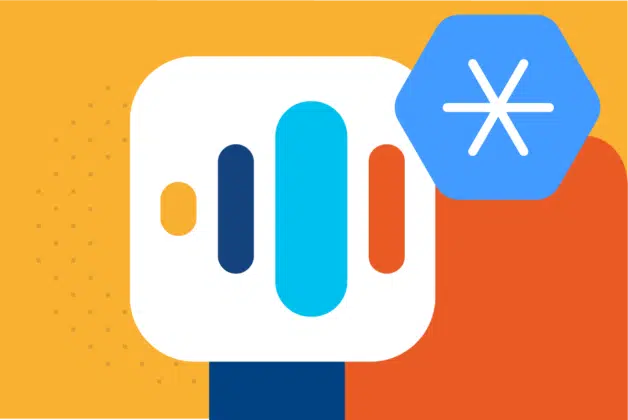

 Tommaso Fioravanti
Tommaso Fioravanti